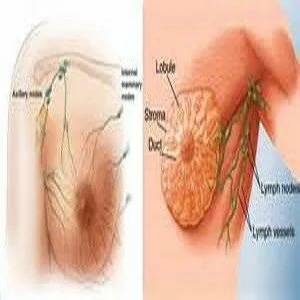1.Breast and cervical cancer
Breast cancer is the commonest cancer in women, with over one million women developing breast cancer world-wide every year.
While it also affects men, the number is quite small compared to women. In the developed world where records are better kept, it is one in nine women is likely to develop breast cancer in her life time.
There are several risk factors associated with breast cancer, a risk factor is something that increases one’s chance of developing a disease. The risk of developing breast cancer increases with age and off course with sex (female). Other risk factors include previous treatment for cancer in one breast, family history of breast cancer, lack of breast feeding, age of first delivery, race (less common in black women) and consumption of hormones for a long time.
Cervical cancer occurs only in women because men do not have cervix; it has beaten breast cancer as the leading cause of cancer deaths in women in India, killing around 33,000 women every year in India.
Cervical cancer is known to occur because of a virus called the Human Papilloma Virus (HPV) transmitted through sexual contact. Risk factors include having too many children, not enough spacing between children, low nutrition levels and early marriage and promiscuity. The disease can be prevented by vaccination in teenage years.
2.Heart disease
Women are prone to obesity than men, each pregnancy bring additional weight gain,not all the fat is shed after delivery. Obese and overweight individuals have an increased risk of diabetes, heart disease and stroke. Added to the above is poor lifestyle in the name of urbanization such as smoking and alcohol consumption.
3.Osteoporosis
Osteoporosis is thinning of the bone, less bone is formed and so the bone is weak and can break easily. Bone is formed all the time to replace lost bone tissue but the rate of replacement reduces with age. Men and women suffer from osteoporosis but women are far more affected especially post menopausal women..
Risk factors include, sex, body size (small people are more affected), race, age, low level of sex hormone especially oestrogen, diet (low calcium diet), lifestyle (sedentary life, alcohol consumption and smoking).
4.Arthritis
Women are affected with arthritis more than men. They usually develop osteoarthritis after the age of 40. Arthritis is not a single disease – there are over 100 different forms of arthritis. It is a collective term for different individual illnesses, with different features, treatments, complications, and prognoses. The similarity is that they have a tendency to affect the joints and many have the possibility to affect other internal parts of the body. It is mostly related to wear and tear of cartilage (osteoarthritis) or associated with an overactive immune system causing inflammation (rheumatoid arthritis). Some of the causes of arthritis are hereditary factors, infections (bacterial and viral), lack of joint fluid, autoimmunity, etc. Arthritis causes pain and limits the function of your joints. If your arthritis is due to inflammation of the joints then you may experience joint swelling, redness, warmth and stiffness.
5.Obesity
Women are prone to obesity than men, each pregnancy bring additional weight gain,not all the fat is shed after delivery. Obese and overweight individuals have an increased risk of diabetes, heart disease and stroke, and tend to die younger. Obesity in women also causes menstrual abnormality, infertility and miscarriage. Obese pregnant women are at an increased risk of infections, pregnancy hypertension and gestational diabetes. Obese and overweight people are increasing in number by the day worldwide and the World Health Organization has raised the alarm.
6.Type 2 Diabetes mellitus
Women are prone to suffer from Type 2 Diabetes for several reasons among which are:
a.Pregnancy could cause gestational diabetes; women with gestational diabetes and /or large babies stand more risk for type 2 diabetes later in life.
b.Obesity; repeated pregnancies is one the causes of overweight/obesity in women. Obesity increases the body’s resistance to insulin which could lead to type diabetes.
c.Polycystic ovarian syndrome which affects only women also increases the body’s resistance to insulin which can lead to type 2 Diabetes.
7.Depression
Depression is a downswing in mood, a feeling of helplessness and hopelessness, loss of interest in life activities; depression affects more women than men and could be exogenous or endogenous. A depressed person finds it difficult to enjoy anything or even function normally. Causes of depression include grief, love and relationship troubles, genetic, alcohol consumption, obesity, childbirth, menopause etc. In a few cases no cause is identified.
A number suffer from post delivery depression characterized by suicidal tendencies, frequent bouts of crying, sleep disturbance, weight loss, a feeling of guilt and a general lack of interest in their surroundings.
Some other women suffer from a serious condition called postpartum psychosis which results in hallucination, delusion and obsessive thoughts particularly involving the baby.
Post delivery depression could pass away after a while but if prolonged, professional help must be sought. In the case of post partum psychosis, psychiatric treatment is a must.
8.Autoimmune diseases
Autoimmune diseases affect more women than men. Autoimmune diseases are a group of more than 80 disorders in which the immune system produces antibodies against the body’s tissues and attacks and destroys the body’s healthy tissue instead of protecting it from infection or disease. They involve almost every human organ system. Genetic, hormonal and environmental factors are suspected to be the risk factors. Well known autoimmune diseases include Rheumatoid arthritis, Systemic Lupus Erythematosus, Myasthenia Gravis, Multiple Sclerosis and Vitiligo.




No Comments